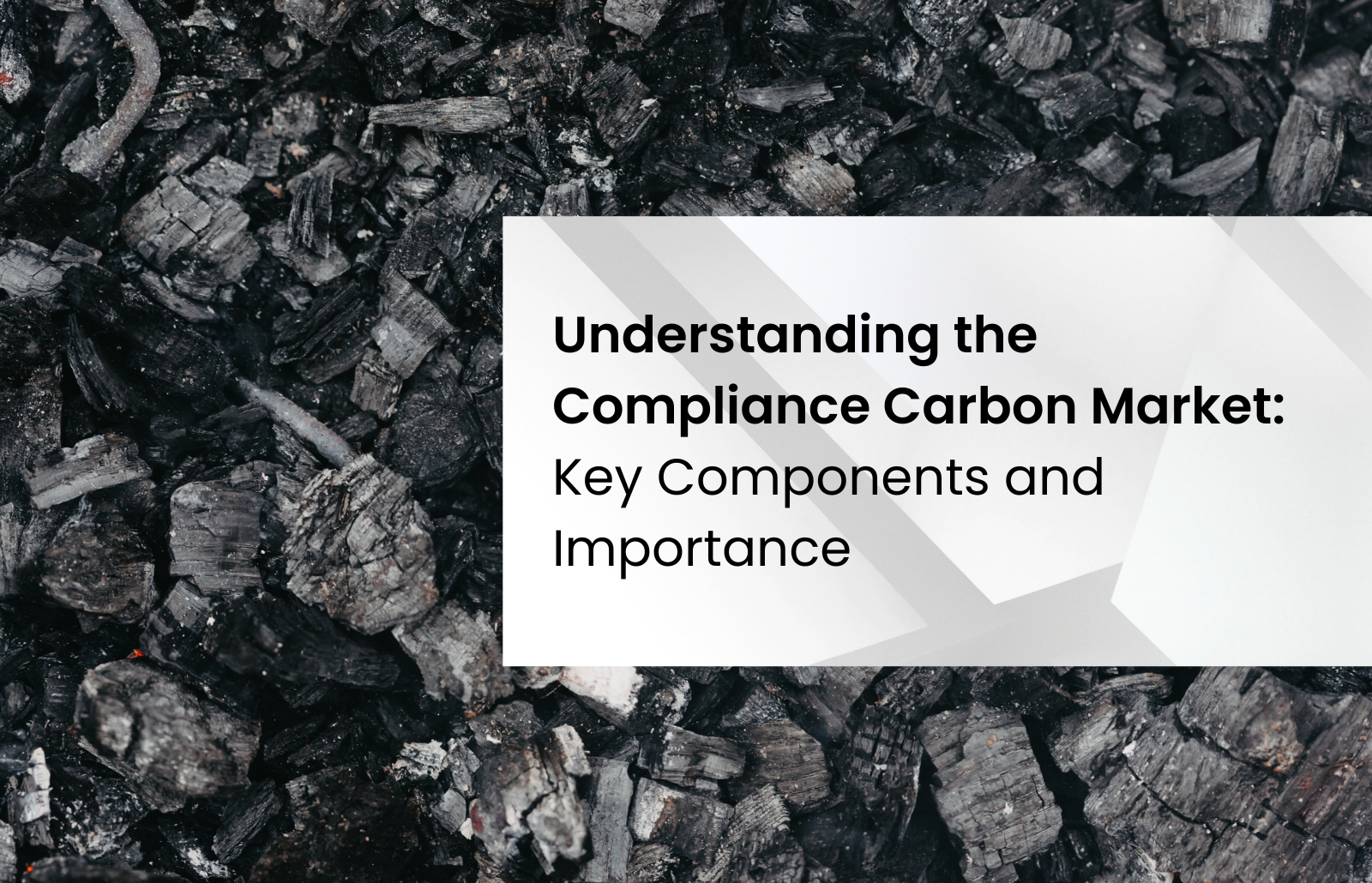One of the marketplaces helping nations win the climate war is the compliance carbon market. It was created to apply, monitor, and enforce emissions reductions that are legally required by a specific industry. As the world’s concern about the environment grows, organisations are turning to this regulated market in increasing numbers to cut through the red tape and make progress towards more sustainable practices.
Companies use this marketplace to meet requirements set by laws and policies, which are sometimes confusing and complicated, and many companies are using it to better their ESG credentials, increase sustainability performance, or simply build up their carbon offset reserves.
The market’s expansion has been expected to be extremely rapid in recent years, but questions remain:
- Is it clear enough for these methods to inspire the necessary shift in corporate behaviour?
- Will they also be able to do it with integrity?
The Compliance Carbon Market
A regulatory carbon market is a framework of requirements established to control and reduce greenhouse gas (GHG) emissions in specific businesses by legally mandated objectives. Organisations that trade or operate in the regulated marketplace must have authorisations or allowances that entitle them to discharge a defined amount of carbon dioxide or an equivalent amount of another pollutant. If a company produces excessive waste, it can purchase additional allowances from another member with surplus permissions to meet its requirements. The system works under strict rules and is subject to several national and international laws, including The European Union Emission Trading Scheme (EU ETS) and California’s Cap-and-Trade Programme. Both markets are regulated by governments with the goal of creating a financial motivation to reduce toxins.
The regulated marketplace will be worth approximately $113.1 billion in 2025, with estimates of $458.4 billion by 2034. The CAGR is 15.6%. Buying and selling emissions credits will soon be a critical component of an organisation’s compliance with greenhouse gas rules and a boost to its ESG standing. Allowances are a common component of the climate strategy and net-zero pledges of the world’s biggest carbon producers.
Industry insiders acknowledge that without a single, robust, legally binding target, emissions trading systems are unlikely to hold polluters responsible or drive long-term investment in and adoption of sustainable practises.
The Evolution of Compliance Carbon Markets
The earliest regulatory carbon systems may be traced back to the 1997 Kyoto Protocol, which set legally binding emissions reduction objectives for industrialised countries. The Kyoto Agreement set the stage for the first regulated marketplaces, such as the EU ETS, which was launched in 2005. Since then, more governments have implemented regulatory trading systems to meet their responsibilities under international climate treaties.
Cap-and-trade plans, in which market forces help drive the supply and cost of emissions credits, are a key feature of regulatory trading systems that have been established. Climate change has received a great deal of attention from the government in recent years, and authorities’ regulated exchange initiatives have become stricter and more regulated. However, many nations around the world have set up carbon trading initiatives to supplement their strategies for combating climate change, and as of 2025, there were still numerous regulatory trading systems in operation.
The adherence emissions credit sector is expected to be worth USD 458.4 billion by 2025, with a CAGR of 15.6% and the predicted rise in regulatory frameworks and financial incentives. A number of nations, like New Zealand and Turkey, are expanding their regulatory frameworks to encourage the adoption of a carbon trading system for the regulated marketplace, according to the authorities. As a result, several nations have established authorities with the goal of achieving net-zero emissions by mid-century, which is largely accomplished through these regulated marketplace systems.
Environmental economists argue that these cap-and-trade systems also provide significant benefits in addition to lowering pollutants, such as supporting the economic transformation required to reach worldwide climate goals. The emissions trading market faces challenges, like illegal verification procedures for “compliance” emissions schemes that appear to have aided in the adoption of poor credits in the marketplace.
Key Components of Compliance Carbon Markets
Businesses work with various components when it comes to regulatory environmental trading systems. Allowances for trading, a trading system, a regulatory organisation, and a follow-up are some of the components of such initiatives. Allowances to emit are, for example, tradable permits that grant the holder the right to discharge a certain amount of greenhouse gases (GHGs) into the atmosphere. All these elements help businesses to meet their legal requirements in addition to being transparent about their carbon budget or meeting their objectives. The carbon market was predicted to be worth USD 113.1 billion in 2024 and would grow to USD 458.4 billion by 2034, with a CAGR of 15.6% over the forecast period. Experts believe that the value of the regulated marketplace and the role that allowances will have in corporations’ sustainability strategies will keep going up.
Trading Platforms: The second one is the exchange platforms that aid in buying and selling rights to allow pollution. Allowances to trade will enable businesses to do this faster and more efficiently. The trading platform is expected to see more adoption by 2025 as technological development improves the platforms available and the demand for regulated marketplace trading solutions increases. Regulatory organisations have acknowledged that allowances and trading platforms will allow the globe to accomplish its climate goals and make a more sustainable future.
Companies also value these elements, like the most well-known trading platforms: the European Union Emissions Trading System (EU ETS), which is anticipated to take over 60% of the carbon market by the end of the projection period. The following element is the regulated authorities, such as regional cap-and-trade initiatives. The regulated authorities monitor compliance with the regulatory targets, including how much pollution a business or industry can produce. Regulated authorities are in charge of making sure that enterprises meet their legal responsibilities, which are taken with utmost seriousness. The process for each participant to adhere to all laws and regulations that have an effect on the regulated marketplace is known as follow-up. Monitoring, reporting, and verification are the most often used methods of following up. These MRV systems are used by the regulated authorities to track pollutants and make sure that the members are satisfying their responsibilities. There will also be a levy for any lack of compliance, which will punish the company that produces excessive waste and have a credibility impact. Furthermore, according to top environment leaders, the number of corporations that have made net-zero pledges is pushing the investment and credit into carbon trading systems for the regulated carbon market, as it is seen as a way to fulfil their requirements. The participants may obtain credits from regulated cap-and-trade systems in certain countries or from cross-border organisations such as California and Quebec to help them meet their requirements.
The Importance of Compliance Carbon Markets in Climate Strategy
Carbon markets, in general, play an important part in the global climate solution, particularly the regulated carbon market. They offer a coordinated method to help reduce greenhouse gas (GHG) emissions. By pricing the carbon emitted, regulated systems offer companies a monetary incentive to control their climate impact by lowering their emissions. Businesses can offset their carbon footprint by buying and selling credits on these exchanges, lowering the cost of meeting reduction targets. By reducing their emissions, companies such as Dell, Microsoft, and Apple have been able to improve their environmental credentials. The purchasing of offsets is a technique for showing accountability and commitment to progress. Many emissions reductions are accomplished by large, powerful businesses all over the world, with more than half of their emissions off-sets originating from removal-based projects. As much as 81% of offsets obtained by top corporations from 2020 have come from reduction or combined activities, which are the types of investments that are likely to drive financing in the area.
Emissions in the regulated carbon industry are a big business. Mandatory inclusion of organisations in a regulated jurisdiction accounts for the largest market share of the regulated carbon sector in 2024. The growing market share is due to a large number of companies working within legal caps on emissions or regulated schemes with mandatory or planned binding participation. Businesses are encouraged to look for more sustainable, less emissions-intensive practises, and carbon credit markets aid in this innovation. Most recently, SBTi welcomed more than 6,200 firms in the first quarter of 2025 that have verified near-term pollutant reduction targets. It’s also a method to help with worldwide climate change collaboration. When nations trade allowances, they can customise their reduction practises to improve efficiency. The result is lower costs for all countries and a more effective realisation of the global target set out in the Paris Agreement. Emissions trading markets are critical for assisting the world in meeting its climate goals, as seen by more than 6,200 companies’ near-term pollutant reduction targets.
The regulated carbon market, according to the Sustainability group, also aids in the development of a culture of responsibility and responsibility in corporations. This is because of the economic stimuli produced by it for the required reduction goal. The regulated pollution trading system has also been restructured over time in response to these investments in cleaner technologies to drive investment. The global market would expand to USD 10,552.12 billion by 2034, with a CAGR of 32.5%. Companies in the aviation industry have the largest CAGR in the carbon credit industry since they all need to decrease their greenhouse gas emissions. The inclusion of the business in the regulated carbon market is anticipated to be an essential component of worldwide climate strategy.
Conclusion
The environmental carbon market is a system in which participants trade emissions credits in order to meet emissions requirements and decrease overall emissions. The regulated sector of the carbon market is a set of standards and laws that has been put in place to legally compel businesses to restrict and control their carbon emissions in the global fight against climate change. The compliance carbon market is beneficial for a number of causes, one of which is that it gives the climate sector a purpose to pay more attention to its processes. Businesses are given economic motivators to become more environmentally friendly through regulated systems, and investments in green businesses and technologies are driving and increasing innovation. The carbon credits sector may also be made more successful by the use of the regulated carbon market because companies will be more incentivised to decrease the amount of GHGs that they produce. With so many reasons for organisations to increase their participation in the regulated carbon market, there is much more to come.
The potential size of the compliance carbon market is one of the most significant statistics on the page, with a valuation predicted to reach about $458.4 billion by 2034. The increasing use of these emission credits by organisations is significant since they are viewed as a significant method to better their Environmental, Social, and Governance (ESG) standing. Other important components include the fact that regulatory agencies are in charge of assuring businesses adhere to the law, and trading systems enable companies to do so more efficiently, both of which are vital to the successful use of a compliance carbon market.
The regulated carbon market is one of the most crucial components of the global climate strategy, and it is time for businesses and countries all over the world to care more about it. Firms and companies can achieve their emissions reductions with the help of a carbon credit system, or even better, use these tools to build a future for their children. The cap-and-trade systems will change as the world moves closer to 2030. This year’s most critical goal, which is a regulated carbon market, will have to take a long, hard look at how people and businesses will go about reaching their net-zero emissions goal.

